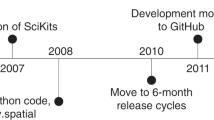
Overview
- Practical and example-based presentation quickly enables readers to start writing their own programs
- The book combines practical tools of computational science with fundamental and generic programming concepts, including object-oriented programming
- Provides a compact introduction to the essential building blocks of programs for data-centric and computational applications
Part of the book series: Simula SpringerBriefs on Computing (SBRIEFSC, volume 6)
Buy print copy
Tax calculation will be finalised at checkout
About this book
This open access book offers an initial introduction to programming for scientific and computational applications using the Python programming language. The presentation style is compact and example-based, making it suitable for students and researchers with little or no prior experience in programming.
The book uses relevant examples from mathematics and the natural sciences to present programming as a practical toolbox that can quickly enable readers to write their own programs for data processing and mathematical modeling. These tools include file reading, plotting, simple text analysis, and using NumPy for numerical computations, which are fundamental building blocks of all programs in data science and computational science. At the same time, readers are introduced to the fundamental concepts of programming, including variables, functions, loops, classes, and object-oriented programming. Accordingly, the book provides a sound basis for further computer science and programming studies.
Similar content being viewed by others
Keywords
Table of contents (9 chapters)
Authors and Affiliations
About the author
Joakim Sundnes is Chief Research Scientist at Simula Research Laboratory and teaches undergraduate programming at the University of Oslo. His research is in scientific computing and computational science, mostly focused on biomechanics and computational physiology, and involves extensive programming in Python and other languages. For the last five years he has been responsible for the main introductory programming class for natural science students at the University of Oslo, and he has also taught multiple graduate courses in computational physiology and applied mathematics.
Bibliographic Information
Book Title: Introduction to Scientific Programming with Python
Authors: Joakim Sundnes
Series Title: Simula SpringerBriefs on Computing
DOI: https://doi.org/10.1007/978-3-030-50356-7
Publisher: Springer Cham
eBook Packages: Mathematics and Statistics, Mathematics and Statistics (R0)
Copyright Information: The Editor(s) (if applicable) and The Author(s) 2020
Softcover ISBN: 978-3-030-50355-0Published: 02 July 2020
eBook ISBN: 978-3-030-50356-7Published: 01 July 2020
Series ISSN: 2512-1677
Series E-ISSN: 2512-1685
Edition Number: 1
Number of Pages: XIV, 148
Topics: Computational Science and Engineering, Professional Computing, Programming Techniques, Software Engineering/Programming and Operating Systems, Mathematics of Computing


